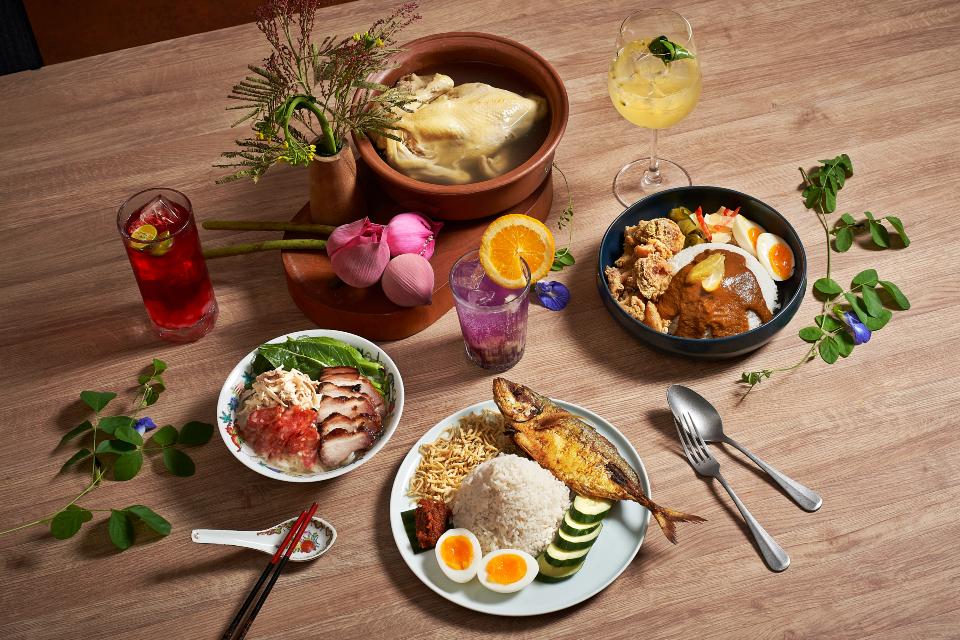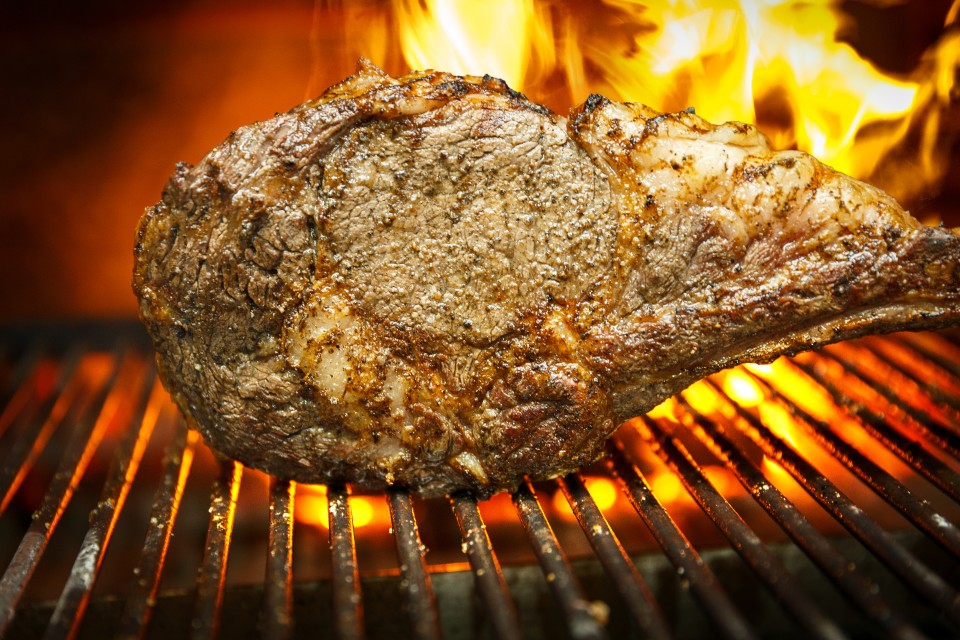Papa of our culinary soul, Chef Damian D’Silva’s all-day restaurant draws on a lifetime of custodianship and elevation of our culinary heritage, to engage the young and further the discourse on Singapore food.
From the very start, Damian D’Silva’s life was rich with variegated flavours. He watched his maternal grandma - a Peranakan - proudly cook the dishes of her culture; while ‘Pop’, his paternal grandad,whipped up a storm of Chinese, Malay, Indian and Eurasian food.
Perhaps more importantly he was immersed in everyday food made with heart, from scratch, in the most traditional way. Under his grandparent’s tough but loving eyes, with time and arduous effort, Damian learned to coax out the most soulful flavours. He found magic in ‘how so many ingredients could come together to make something so amazing’.

When Damian D’Silva was just 11, his grandfather who was teaching him recipes asked him why he wanted to learn them. Damian replied, ‘So that I can still eat the food you cook when you die.’ Precocity had told the child that heritage was not so much for the dead as for the living. It also told him that it would take energy and dedication to keep that heritage alive; make it relevant; and pass it on. In a nutshell, that describes Rempapa.

Damian grew up in a kitchen where fidelity to correct ‘form’ was sacrosanct. Where shortcuts and compromise were taboo; and where food was crafted by hand from scratch -- he walked the path of the artisan long before the word became fashionable. He propagated our food values; told our stories; stood in custody of our traditions. He kept faith with the cause. Now with his new personal philosophy -- ‘Singapore New Heritage Cuisine’ – he takes it a step further.

His Rempapa’s Pork Chop Curry Rice ($18) is a superb example. Knowing that pork katsu-don is a favourite amongst young Singaporeans, Damian created a dish that took inspiration from ‘Hainanese curry rice’. The result is familiar by sight but with a different flavour, which he hopes will entice younger guests to ‘come and eat’ and ‘let’s talk’ later.
Damian crumbs the pork with hand-pounded cream crackers as per the classic Hainanese recipe before deep-frying. He believes that the typical curry cooked at home today contains only curry powder without dry spices; so he re-works the curry gravy into something familiar but with more nuance and depth of flavour -- that would strike a chord with youth and open a conversation on what a true curry is.
Damian cooks the curry by first tempering dry spices of cardamon, coriander, cumin and fennel – a more toned down reflection of traditional Indian flavours. However, unlike traditional practice, he removes these spices before adding the curry powder, so as not to overwhelm the palate, especially of the less experienced. The curry also contains garam masala, reflecting its Indian, Eurasian, and Malay influence. Damian finishes it off with refreshing radish pickles – something all heritage races in Singapore are familiar with.

A similar creation is Chicken Curry ($28). Damian knows that thick, overly rich gravies do not appeal to young eaters; but neither do they like ones that are too watered down (seen as ‘lacking punch’). Through deep research into various ethnic versions of the dish, Damian has isolated the key flavour elements and experimented on them.
Therefore in his Singapore New Heritage iteration, the makeup contains Indian and Eurasian curry powder mixes; a rempah base adopted from the Malay gulai; coconut water instead of plain water (as the Chinese would do); and more coconut milk following the Indians of Sri Lankan descent; with blue ginger and lemon grass (borrowings from the Peranakan larder).
Using this approach Damian tempts the diner with dishes such as Fried Chicken Curry Rice ($16), Braised Beef with Raita and Roti ($25), Seafood Curry Mee ($18), and Coconut Custard with Gula Melaka ($14).

The Sri Lankan Chicken Curry and Tomato Chutney with String Hoppers ($16) offers a traditional thin curry that becomes a sublime match with the steamed hoppers when soaked with gravy. In Singapore, these string hoppers, referred to as idiyappam or putu mayam, are commonly eaten with coconut and sugar.
Traditionally, however, they are eaten with curries or chutney. For curries, Indians from Sri Lanka usually use both whole and ground spices – in this dish, dry spices such as whole cloves, cinnamon, and star anise are first tempered in ghee; this is followed by the addition of sliced and blended Bombay onions, Bentong ginger, and garlic.
Coconut milk is also added in a manner typical of Sri Lankan curries as Indians prefer yoghurt. The curry and hoppers are served with a tangy tomato and date chutney made of golden raisins and mustard seeds, bound together with a fruity coconut vinegar that is often used by Indians and Eurasians for pickling.

The Braised Beef with Raita & Roti ($25) is a seemingly ordinary bowl of beef goulash until one’s first mouthful of the tender brisket, revealing elements from Eurasian and Indian cuisines. The Singapore New Heritage dish offers nuances of ground cumin and coriander seeds, usually present in Indian and Eurasian cooking.
While Eurasians typically add bay leaves to braises and stews, Damian chose to use daun salam, a local bay leaf native to Indonesia that imparts earthier notes with a hint of citrus. More Eurasian flavours are extracted from the inclusion of sweet paprika powder, fresh red tomatoes, and blistered red bell peppers. Raita, an Indian side dish, is a refreshing pairing for the braised beef and roti.
Damian believes that chickpea is food for the future – a wonderful balance of soft texture without mushiness which absorbs flavours well. The vegetarian-friendly Chickpea with Roti ($18) is cooked with blistered red bell peppers, fresh red tomatoes, Kashmiri chilli powder, and turmeric powder, and the result is an amalgamation of Indian and Eurasian curry flavours. To complete the dish, mustard seeds are quickly popped in ghee and added to the chickpea mixture.

The recipe for Stir-Fried Chee Cheong Fun ($13) came from a young chef at Rempapa – Ah Seng -- who hails from Penang. He had cooked his hometown’s hawker dish for the team. The original dish uses dried shrimps; here, the chee cheong fun is wok-fried with prawns and eggs, as well as yellow chives.

The Nasi Lemak began with Damian’s desire to share its rare flavours with the next generation. Damian presents it here as a simple version for an easy breakfast ($5), or as the full works ($17) for a hearty lunch or weekend brunch. Traditionally the banana leaf-wrapped parcels contained only coconut rice, sambal, and fish caught the same morning.
Broken rice was used as it was more economical; to make it flavourful, it was cooked with coconut milk – first by steaming the grains dry so that they would absorb the liquid, then cooking them a second time. Sambal, synonymous with Malay cuisine, was made with tamarind or lime as the lemak rice called for an accompaniment that would counterbalance its richness. Ikan bilis were later additions.
Damian substitutes broken rice with ‘old’ jasmine rice that is soaked overnight, then cooked in a laborious 3- hour process with fresh coconut milk. The accompanying sambal is made with a base of classic rempah titek and finished with sugar, salt, and finally a dash of lime at the end for restrained acidity tailored for today’s tastebuds.
Instead of ikan bilis, the rice is paired with Japanese silver fish for a delicate crisp. Eggs are offered as either a 7-minute egg or a sunny side-up. For lunch and brunch, a choice of either chicken or fish is offered. The kampong chicken thigh is coated in a dry rub of ground coriander seed, fennel seed, cumin seed, Kashmiri chilli powder, and turmeric powder for at least 36 hours before it is deep-fried, while the selar fish is coated with turmeric powder and tamarind juice for 30 minutes, then pan-fried.

In the 1960s, Boat Quay and Clarke Quay were a foodie's paradise where hawkers peddled their ware along the streets to feed coolies working at the docks. It was also a favourite haunt of office workers from the vicinity. Grandad had brought young Damian to sample some of the dishes, which included kai fan (kai refers to ‘street’; ‘street rice’). Its simple flavours lingered in Damian’s mind through the years; transformed today into a soulful bowl of Kai Fan ($18) with shredded chicken, char siew, lup cheong, and chye sim immersed in comforting chicken stock.
Plated like a Japanese curry with karaage, the Fried Chicken Curry Rice ($16) combines the essences of Eurasian, Peranakan, Indian, Malay, and Chinese cuisines. Chicken is seasoned with a 12-spice house-blended masala for at least 48 hours before it is coated lightly in cornflour then deep-fried into crispy morsels. Dry spices in the curry include ground cumin and coriander seeds (from Indian and Eurasian curries), turmeric (from Malay and Chinese curries), while the wet spice paste is a classic rempah titek – a Peranakan touch. Light soya sauce (influenced by the Chinese) is added to taste.
The familiar visual of this Singapore New Heritage dish entices the younger generation, with the bigger goal of introducing heritage flavours. Damian believes that heritage food can only be promoted when people like it in the first place. When they do, the food then becomes a story that the next generation wants to listen to. Otherwise, it will be a lost cause.

The Fried Nyonya Fish Cake ($18), offered as an appetiser for dinner or as a bar snack, is an introduction to a heritage Peranakan dish that may not be familiar even to Peranakans. In Peranakan households, cherished heirloom recipes vary according to family origins – whether ancestors hail from Penang, Malacca, Terengganu, Thailand, or Indonesia. Damian concocts his rempah from chillies and belacan and other ingredients, mixed with a spotted mackerel fish paste. It is quickly steamed, then deep-fried. The flavour is a combination of otah and fish cake that is springy, moist, and slightly burnt at the edges for textural crisp – just like how a young Damian loved it.

Lamb has always been Damian's favourite choice of protein because of the flavour and subtle sweetness arising when it's cooked. The Lamb Leg Rendang ($38), based on the classic Minangkabau dish with Malay and Indonesian influences, includes a wet spice blend as well as a masala spice blend, cooked in fresh coconut milk. Damian adds herbs such as daun salam (Indonesian bay leaf) and kaffir lime leaves, then it is left to cook over a low to medium flame until the sauce thickens and the lamb meat is tender. In the D’ Silva household, when Grandad was around, rendang was always cooked using lamb.
Ayam Kalasan ($17) is a Malay dish of Indonesian heritage from Aunty Zainab, whose husband is best friends with Damian’s dad. Aunty Zainab would cook for her kids, and whenever Damian visited, she would cook this dish too. Diners sipping on heritage cocktails will find it a complementary snack with familiar flavours.
The chicken wings are slowly braised in coconut water flavoured with a blended paste of candlenut, galangal, chilli, fresh turmeric, and tamarind juice, simmered till near evaporation. The chicken is then removed and dried before being deep-fried. The leftover liquid is not wasted but turned into a flavourful sambal made of chilli, onion, and candlenut that's served with the dish.

The moreish Limpeh Sliders ($22 – 2 pcs), served with pickled cucumber, is a fresh way to enjoy heritage flavours – a Singapore New Heritage dish. The beef brisket is cooked in the same rempah used for the lamb leg rendang, then stuffed into a crispy pastry parcel. This local take on sliders captured a loyal following during Damian’s pop-up, South-East Sliders, which ran from 2015 to 2017. Damian presented 2 types of sliders then – The Big D and the Limpeh Slider. A new expression of the latter can now be enjoyed at Rempapa.

Heritage desserts are served in the afternoon as a Kueh Platter ($6/$10/$15 – 4/8/12 pcs). The selection will be drawn from the dessert menu which includes favourites such as Kueh Kosui and Kueh Ku, Kueh Bengkah, Pulut Bengkah, Talam Keladi, Sago Ubi, Lapis Pulot, Rempah Udang and others available on the day.

The Durian Bengkah – a fragrant union of the classic Kueh Bengkah and the King of Fruits. Damian grew to understand Kueh Bengkah after making it many times over and thought of tweaking it by adding his favourite fruit. He made an early version of this recipe and gifted it to his mother, not telling her that it was from his own hand. She loved it so much that she wanted to buy another one of these cakes for herself. That was the moment Damian knew it belonged on the menu of Rempapa.

Talam Keladi, meaning ‘tray’ and ‘yam’ respectively, is a traditional Malay steamed kueh comprising two layers: gula melaka custard on top, and mashed yam cake on the bottom. Yam was a nutrient-dense staple in Singapore after World War 2, during a time of limited food rations such as rice. Gula melaka adds a natural caramel yellow to the custard layer. This heritage dessert is based on a recipe from Damian’s aunt, and he often enjoyed the kueh while growing up.

When Damian tasted koka (a Basque caramel flan) for the first time, he was inspired by its texture and felt that a local version using coconut milk and gula melaka would be sublime. And thus, Coconut Custard with Gula Melaka ($14) was born. The first experiment was some 10 years ago; since then it’s gone through changes to achieve the right balance of texture and flavour -- silky smooth on the palate with sweetness and richness complementing each other, and gula melaka adding an earthy caramel touch.
a. 2 Paya Lebar Rd, 01-01/02/03 Park Place Residences at PLQ, Singapore 409053















